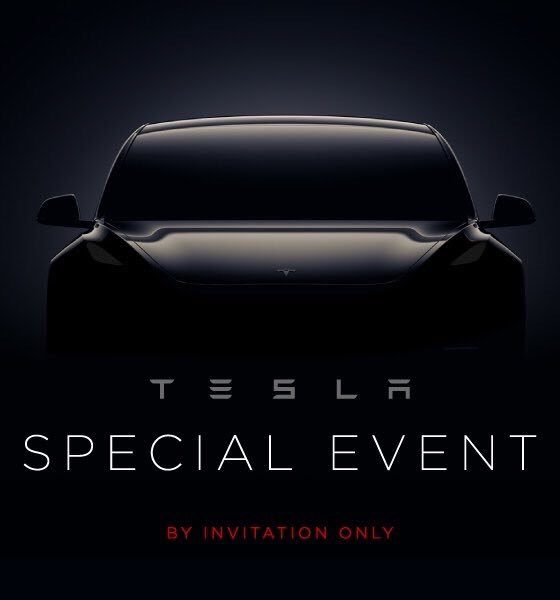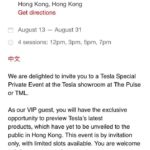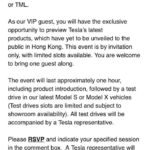

News
Tesla poised to bring Model 3 to Hong Kong as GM’s EV push falters in China
Tesla seems to have reached a point in the Model 3 production that it is now confident enough to start promoting the vehicle to other regions. Just a couple of weeks after bringing the car to Australia and New Zealand, Tesla seems poised to showcase the electric sedan in Hong Kong.
Invitations for the Hong Kong event were recently shared online. The Model 3 was not explicitly mentioned by the company in its communication, though the vehicle’s unmistakable outline could be recognized in the invite. The company’s email to the Tesla community in HK reveals that the “Tesla Hong Kong Special Event” will run until August 31, and would include four sessions, at 12 p.m., 3 p.m., 5 p.m., and 7 p.m. The special event would be held at Tesla The Pulse or TML.
The communication from Tesla indicates that attendees would have to RSVP. A product introduction would be conducted, followed by test drive sessions in the Model S and Model X. Following is a screenshot of the email the company sent out to the Tesla community in Hong Kong.
- An invitation for a special Tesla event in Hong Kong. [Credit: Model 3 Owners Club/Twitter]
- An invitation for a special Tesla event in Hong Kong. [Credit: Model 3 Owners Club/Twitter]
- An invitation for a special Tesla event in Hong Kong. [Credit: Model 3 Owners Club/Twitter]
Tesla’s invitation for a special event in Hong Kong. [Credit: Model 3 Owners Club/Twitter]
It is now more than a year into the production of the Model 3, and Elon Musk’s self-imposed “production hell” appears to be nearing its end. Tesla is expected to produce and deliver record numbers of Model 3 this third quarter. Nomura Instinet analyst Romit Shah recently noted that the electric car maker could produce as much as 65,000-70,000 Model 3 this quarter, especially since Tesla appears to have breached the 6,000/week mark this August.
While Tesla appears to be preparing to showcase the Model 3 to Hong Kong, rival General Motors is running into problems with its EV push in China. GM is aiming to compete in the hyper-competitive EV sector in the country, and it has selected its plug-in hybrid Buick Velite 6 — a local variant of the Volt — as one of its key vehicles. An all-electric car is also planned for next year.
Unfortunately for GM, its EV initiative has hit a roadblock after it found that the battery packs supplied by A123 Systems, one of its suppliers, are not up to par in terms of performance and safety standards. A123 Systems is a Livonia, Michigan company that was bought out of bankruptcy by Chinese auto parts giant Wanxiang Group Corp. in 2013. The company operates a battery factory in the city of Hangzhou to supply packs for the Chinese market.
In a statement to the Wall Street Journal, Thomas Barrera, president of LIB-X Consulting, a battery consultancy based in Long Beach, CA, noted that there are risks to some of the inexpensive battery solutions being produced in the Asian country.
“There are concerns with the quality of Chinese-manufactured cells and batteries. Chinese cells are very attractive because they’re inexpensive, but people may not realize that these cells may not have gone through the necessary qualification testing before going to market,” he said.
Tesla is also looking to breach the Chinese electric car market, though it aims to accomplish this using its trademark in-house development strategy. The company is currently looking to start the construction of Gigafactory 3 in Shanghai, which would produce its own batteries and be equipped to handle the production of electric cars. When complete, Tesla estimates Gigafactory 3 to build as many as 500,000 electric vehicles per year.

News
Tesla starts showing how FSD will change lives in Europe
Local officials tested the system on narrow country roads and were impressed by FSD’s smooth, human-like driving, with some calling the service a game-changer for everyday life in areas that are far from urban centers.

Tesla has launched Europe’s first public shuttle service using Full Self-Driving (Supervised) in the rural Eifelkreis Bitburg-Prüm region of Germany, demonstrating how the technology can restore independence and mobility for people who struggle with limited transport options.
Local officials tested the system on narrow country roads and were impressed by FSD’s smooth, human-like driving, with some calling the service a game-changer for everyday life in areas that are far from urban centers.
Officials see real impact on rural residents
Arzfeld Mayor Johannes Kuhl and District Administrator Andreas Kruppert personally tested the Tesla shuttle service. This allowed them to see just how well FSD navigated winding lanes and rural roads confidently. Kruppert said, “Autonomous driving sounds like science fiction to many, but we simply see here that it works totally well in rural regions too.” Kuhl, for his part, also noted that FSD “feels like a very experienced driver.”
The pilot complements the area’s “Citizen Bus” program, which provides on-demand rides for elderly residents who can no longer drive themselves. Tesla Europe shared a video of a demonstration of the service, highlighting how FSD gives people their freedom back, even in places where public transport is not as prevalent.
What the Ministry for Economic Affairs and Transport says
Rhineland-Palatinate’s Minister Daniela Schmitt supported the project, praising the collaboration that made this “first of its kind in Europe” possible. As per the ministry, the rural rollout for the service shows FSD’s potential beyond major cities, and it delivers tangible benefits like grocery runs, doctor visits, and social connections for isolated residents.
“Reliable and flexible mobility is especially vital in rural areas. With the launch of a shuttle service using self-driving vehicles (FSD supervised) by Tesla in the Eifelkreis Bitburg-Prüm, an innovative pilot project is now getting underway that complements local community bus services. It is the first project of its kind in Europe.
“The result is a real gain for rural mobility: greater accessibility, more flexibility and tangible benefits for everyday life. A strong signal for innovation, cooperation and future-oriented mobility beyond urban centers,” the ministry wrote in a LinkedIn post.
News
Tesla China quietly posts Robotaxi-related job listing
Tesla China is currently seeking a Low Voltage Electrical Engineer to work on circuit board design for the company’s autonomous vehicles.

Tesla has posted a new job listing in Shanghai explicitly tied to its Robotaxi program, fueling speculation that the company is preparing to launch its dedicated autonomous ride-hailing service in China.
As noted in the listing, Tesla China is currently seeking a Low Voltage Electrical Engineer to work on circuit board design for the company’s autonomous vehicles.
Robotaxi-specific role
The listing, which was shared on social media platform X by industry watcher @tslaming, suggested that Tesla China is looking to fill the role urgently. The job listing itself specifically mentions that the person hired for the role will be working on the Low Voltage Hardware team, which would design the circuit boards that would serve as the nervous system of the Robotaxi.
Key tasks for the role, as indicated in the job listing, include collaboration with PCB layout, firmware, mechanical, program management, and validation teams, among other responsibilities. The role is based in Shanghai.
China Robotaxi launch
China represents a massive potential market for robotaxis, with its dense urban centers and supportive policies in select cities. Tesla has limited permission to roll out FSD in the country, though despite this, its vehicles have been hailed as among the best in the market when it comes to autonomous features. So far, at least, it appears that China supports Tesla’s FSD and Robotaxi rollout.
This was hinted at in November, when Tesla brought the Cybercab to the 8th China International Import Expo (CIIE) in Shanghai, marking the first time that the autonomous two-seater was brought to the Asia-Pacific region. The vehicle, despite not having a release date in China, received a significant amount of interest among the event’s attendees.
Elon Musk
Elon Musk and Tesla AI Director share insights after empty driver seat Robotaxi rides
The executives’ unoccupied tests hint at the rapid progress of Tesla’s unsupervised Robotaxi efforts.

Tesla CEO Elon Musk and AI Director Ashok Elluswamy celebrated Christmas Eve by sharing personal experiences with Robotaxi vehicles that had no safety monitor or occupant in the driver’s seat. Musk described the system’s “perfect driving” around Austin, while Elluswamy posted video from the back seat, calling it “an amazing experience.”
The executives’ unoccupied tests hint at the rapid progress of Tesla’s unsupervised Robotaxi efforts.
Elon and Ashok’s firsthand Robotaxi insights
Prior to Musk and the Tesla AI Director’s posts, sightings of unmanned Teslas navigating public roads were widely shared on social media. One such vehicle was spotted in Austin, Texas, which Elon Musk acknowleged by stating that “Testing is underway with no occupants in the car.”
Based on his Christmas Eve post, Musk seemed to have tested an unmanned Tesla himself. “A Tesla with no safety monitor in the car and me sitting in the passenger seat took me all around Austin on Sunday with perfect driving,” Musk wrote in his post.
Elluswamy responded with a 2-minute video showing himself in the rear of an unmanned Tesla. The video featured the vehicle’s empty front seats, as well as its smooth handling through real-world traffic. He captioned his video with the words, “It’s an amazing experience!”
Towards Unsupervised operations
During an xAI Hackathon earlier this month, Elon Musk mentioned that Tesla owed be removing Safety Monitors from its Robotaxis in Austin in just three weeks. “Unsupervised is pretty much solved at this point. So there will be Tesla Robotaxis operating in Austin with no one in them. Not even anyone in the passenger seat in about three weeks,” he said. Musk echoed similar estimates at the 2025 Annual Shareholder Meeting and the Q3 2025 earnings call.
Considering the insights that were posted Musk and Elluswamy, it does appear that Tesla is working hard towards operating its Robotaxis with no safety monitors. This is quite impressive considering that the service was launched just earlier this year.











